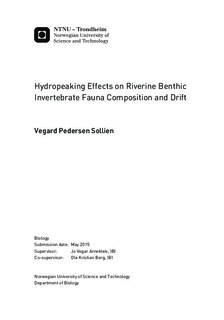Hydropeaking Effects on Riverine Benthic Invertebrate Fauna Composition and Drift
Master thesis
Permanent lenke
http://hdl.handle.net/11250/2351546Utgivelsesdato
2015Metadata
Vis full innførselSamlinger
- Institutt for biologi [2596]
Sammendrag
In earlier studies, changes have been detected in the composition of the lotic benthic macroinvertebrate fauna as a consequence of hydropeaking. Rapid fluctuations in discharge lead to sudden dewatering of river bed area when discharge drops. Stranding of organisms is a well known consequence of dewatering. But also in the water column, hydropeaking leads to frequent changes in the habitats. In rivers, where stranding in greater or lesser extent always occurs with rapid discharge fluctuations, it may be difficult to distinguish whether the observed changes in invertebrate fauna is caused by the stranding, or if other factors play a role as well. An experiment was therefore performed with rapid discharge fluctuations in a setup with semi-natural stream channels in Paltamo, Finland, where dewatering of the river bed was eliminated. The stream channels were kept under two different discharge regimes in both a winter and a summer experimental period. Abiotic factors and total water flow throughout the experimental periods was identical for each of the stream channels. Hence, we could test if rapid discharge fluctuations without dewatering changed the benthic macroinvertebrate density, diversity and drift.The study revealed no significant changes in the total density of benthic macroinvertebrates or for the density within the taxonomic groups. Small indications of changes within individual groups could be observed, though. Drift samples show the same indication of changes in some lower taxonomic levels, but mostly no changes were detectable. This is consistent with earlier studies in which it have been shown that drift densities of macroinvertebrates are higher immediate after a peaking operation. The results from this study imply along with the earlier findings that the major challenges for the lotic fauna under a hydropeaking discharge regime are dewatering and stranding.
